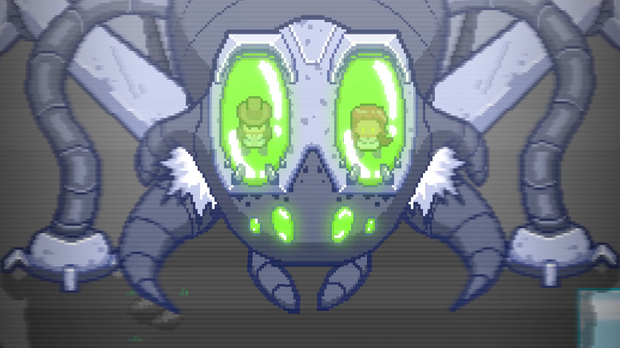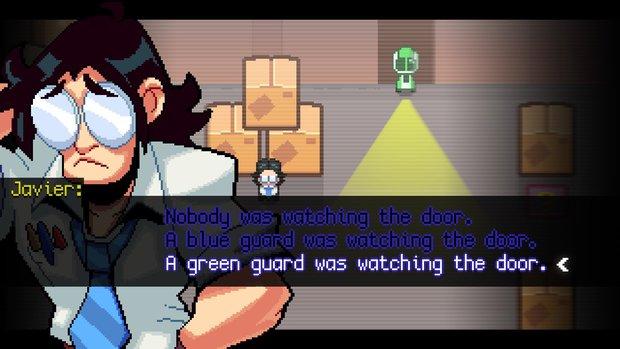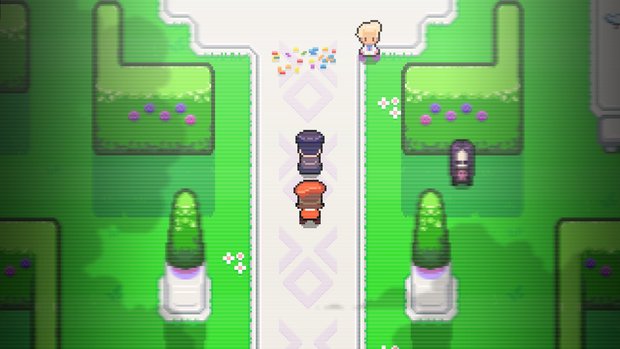RE:CALL review

- 0 Comments
Retro-RPG-styled blend of elements makes some interesting if not totally successful choices
Nine times out of ten, when reviewing a game that combines a multitude of disparate gameplay elements, I’d expect to use phrases like “identity crisis” and “all over the place” to describe the experience. I guess Matías Schmied’s indie effort RE:CALL is that tenth instance, because even though the game shifts gears from visual novel to puzzle game to stealth mission to superhero adventure, and hops between timelines and multiple protagonists to boot, the gameplay feels well-implemented and never paradoxical or unfocused. It does, however, face that very problem with its storytelling, as it struggles to present a fully cohesive narrative, leading to a diminished but still interesting offering worth checking out for those looking for something a little different.
There’s no easy way to sum up RE:CALL’s gameplay. An extremely interesting narrative structure is introduced early on, which the game sticks with … until it doesn’t anymore. The majority of the seven chapters cover events that have already taken place, narrated by their respective playable characters to others after the fact. For instance, the first chapter features a man named Javier, who has invaded the headquarters of a notorious crime boss, the Toy Maker, in order to assassinate him. Upon reaching the Toy Maker’s private office, the tables are turned and Javier is outnumbered and held up at gunpoint. Naturally, the Toy Maker wants to know how and why Javier attempted to infiltrate his warehouse, so the chapter is essentially a playable flashback of Javier telling him this story, in between returns to the present at key moments.
This is where the game’s (initial) time-altering gameplay mechanic comes into play, directly influencing its story progression in the process. Heading straight toward the Toy Maker’s inner sanctum quickly results in capture, as Javier will be identified, outgunned, or unable to bypass the warehouse’s security systems, forcing you to try again using a different approach. Each failed attempt necessitates a chapter restart (though they’re so bite-sized it’s a negligible time penalty) but at least you’re now newly clued in on another part of the puzzle that must be solved. For example, procuring a guard’s uniform will allow Javier to move around undetected, while hacking the warehouse’s security mainframe will unlock the office door. But because Javier is narrating all this in the present, performing these key actions in the past has a direct effect on his current situation. Stealing a guard’s gun in his flashback means that same guard will now be disarmed in the present, while Javier is the one packing during his encounter with the Toy Maker instead.

You see major changes happen in the present in real time as you make choices in the past, and characters react to them with as much confusion and bewilderment as you might expect (providing some genuinely amusing reactions). Since the confrontation with the Toy Maker is inevitable, it’s your job to find the right path to trigger the meeting while setting the stage to the most optimal conditions for Javier to survive the confrontation and succeed in his mission, eliminating each fail condition one by one so Javier can carry out his hit.
My assumption was that each of the game’s seven chapters would run with this intriguing gameplay premise, upping the ante on complexity each time, making for progressively more confusing puzzles to untangle in various different scenarios. But after the first few chapters, the formula suddenly shifts. But not to worry – the chapters that ditch these puzzle mechanics replace them with other, equally engaging elements, while keeping the “story told through flashback” mentality. It seems like the developer was willing to let the content of each chapter dictate its gameplay. One (very short) chapter removes all puzzle and stealth elements and plays out more like a visual novel, while another will see you take control of several teams of superheroes in turn, each with their own unique powers, and progress through a large level filled with enemies and obstacles three different times using only the superpowers on hand. Once I knew to expect the unexpected, each new chapter brought with it a feeling of anticipation, wondering what new gameplay styles or narrative choices I’d get to see next.
The shifting gameplay occurs alongside another, more impactful shift: RE:CALL thinks nothing of changing its main protagonist, and not just once. Take, for instance, the aforementioned Javier from chapter one. Much like the Toy Maker, I was intrigued by who this character was and what his motivations really were; his dialog heavily hints at several secrets surrounding him. But just as I was primed to learn more, the end of that chapter signaled Javier to be replaced (though we’re not quite done with him yet) by Bruno Gallagher, a young, unremarkable man who takes center stage for much of what’s to come. Although I think Bruno could really be considered the game’s primary protagonist, this isn’t the last time the spotlight swivels to someone new.

Changing gameplay elements and alternating protagonists is one thing, but it’s the story where more cohesion is sorely needed. While the gameplay heading off in different directions generally works well, the story has a general feeling of whiplash, particularly early on. It more resembles a series of (apparently) unrelated events: secret organizations, assassinations, and supernatural occurrences are referenced repeatedly, though not in a way that really lets us connect the strands of the web to form a deeper understanding. Eventually we’ll discover that there’s a villain with a dastardly scheme to be stopped, but the narrative shrouds itself in too much secrecy for far too long to build up a good head of steam.
Surprisingly, the characters themselves can be just as confusing. Once we’ve met Bruno, many of the other players are introduced. People like the pompous Lucas (who was once Bruno’s friend before becoming popular at school and ditching him) and the rich socialite Henrietta (whom Bruno holds a bit of a torch for) fit into the narrative without any issue, but the same cannot be said for others. Less successful is the handling of Harry Ocean, who is introduced as Bruno’s friend when he accompanies him to Henrietta’s party, even though Bruno seems to have never met him before. There’s also some fourth-wall-breaking that implicates the player personally in the proceedings. As we get nearer to the final chapter, the game attempts to recontextualize a few of its characters, again with mixed results, even while still introducing more new faces.
This means we are often left unsure of what characters’ relationships are with each other, and – even worse – who the villains even are. Very little seems to be what it first appears, and we are generally asked to just take everything at face value and not ask any questions. What starts out as enigmatic yet intriguing ends up being far too cryptic and unsatisfying. I can’t help but wonder if some of this, at least, is due to a translation that struggles with some of the game’s headier, more cerebral themes. It’s also evident in much of the moment-to-moment dialog, which includes its fair share of awkward phrasing and grammar.
While the story’s back-and-forth quality doesn’t serve the game as well as it might have, its presentation does rather work in its favor. At first glance, RE:CALL looks like a number of other top-down games based on the RPG Maker engine, only here the graphics are far cleaner and simpler to take in than most. It’s a little hard to quantify, but it’s almost as if the aim is less about attaining that 16-bit RPG look (though it certainly is retro chic, make no mistake) and more about presenting an uncomplicated bird’s-eye view of the protagonists’ everyday world drenched in vibrant color.
The visual novel-styled dialog, while only accompanied with differently pitched bleeps and bloops rather than voice acting, treats us to some very nice character designs lovingly showcased via full-screen pixel art portraits that make them the clear stars of the screen. The action is accompanied by good music, with many serviceable background tracks and even the occasional standout pop/rock composition, complete with vocals.
Final Verdict
Ultimately, RE:CALL is a game best recommended to those with an interest in quirky stories that don’t require a ton of time investment. The whole game can be completed in a handful of sittings (around five or six hours), and while the memory manipulation storytelling device spices up the way the first half is presented, the rest of the narrative dictates the moment-to-moment gameplay in the second half and never feels like more of the same. Tinkering around with how different choices affect characters in the present is a fun gimmick while it lasts, and the challenge bar is low enough to keep it from ever becoming frustrating or redundant, yet the ideas that replace it later are just as compelling. Despite the narrative not always being as clear as I would have liked, RE:CALL is a neat idea presented in a pleasant package, and something that stands a bit apart from its peers.
Hot take
Combining several gameplay styles with a protagonist-switching, fourth-wall-breaking story makes RE:CALL feel almost experimental at times. But since its disparate elements ultimately work reasonably well together, it’s an experiment in storytelling that could be worth checking out.
Pros
- Intriguing memory-malleability mechanic while it lasts
- Any gameplay changes are always in service to the story
- Great character art during dialog really brings the cast to life
Cons
- Narrative pieces ultimately fail to come together
- Too many unclear character relationships
- Occasionally wonky translation
Pascal played RE:CALL on PC using a review code provided by the game's publisher.










0 Comments
Want to join the discussion? Leave a comment as guest, sign in or register in our forums.
Leave a comment